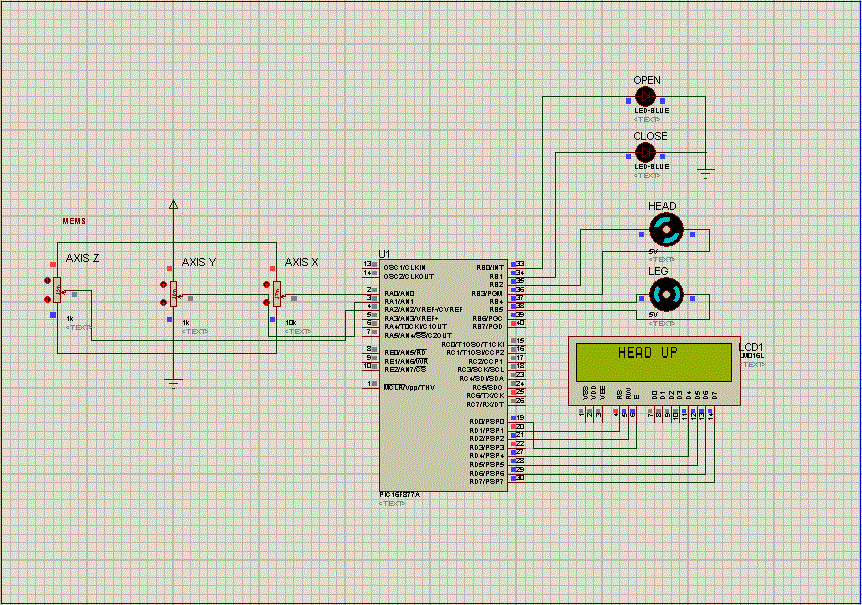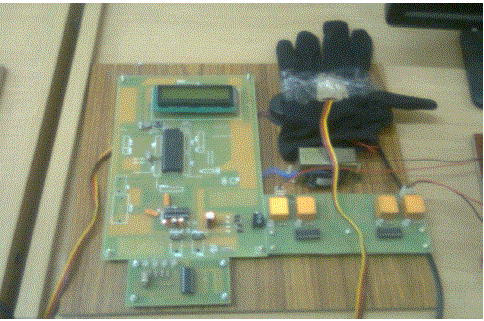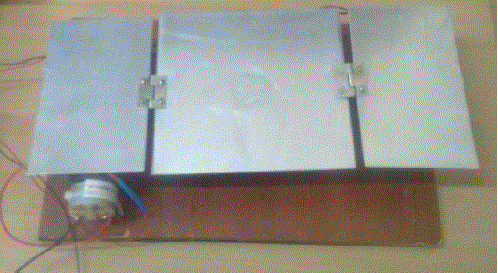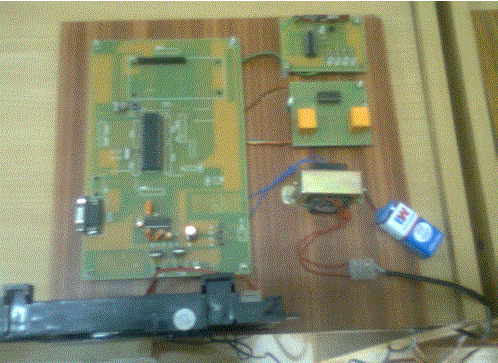This paper presents a prototype model for gesture recognition using MEMS accelerometer .The system is capable of recognizing gestures from MEMS 3-axes accelerometer and it is mainly targeted for hospital applications .The acceleration of hand in all directions were detected by 3-axes MEMS accelerometer. According to the acceleration values corresponding motors were enabled using Microcontroller, to perform tasks like bed positioning & windows open and close using RF transmitter & receiver.LCD is used to display the command which is performed from time to time.
Keywords |
| MEMS accelerometer, RF transmitter & receiver, Liquid Crystal Display |
INTRODUCTION |
| Gesture recognition is one of the most important area of research these days. As human to machine interaction has been
more quite often these days, physical gestures were used as a language for this communication. Several devices like
camera, joystick, track ball etc were available for capturing gestures. However each device has its own limitations like
mobility, cost etc. In this work, MEMS based accelerometer is used which is compact in size and make it feasible to
use wherever it required. Several works using MEMS accelerometer were available. [4]Ruize Xu et al, discussed about
three different gesture recognition models like sign sequence and Hopfield network, velocity increment , sign sequence
and template matching respectively which has the capability to detect seven hand gesture like up, down, left, right,
tick, circle, cross based on input from 3-axes accelerometer. Out of the three models they recommended sign sequence
and template matching technique because of its highest overall recognition accuracy. Because of this high accuracy
template matching technique is also implemented for gesture recognition in our work. |
EXISTING SYSTEM |
| Several gesture recognition systems using MEMS accelerometer for various applications like direction controlled wheel
chairs, unwired mouse navigation systems etc were available. [2]Mangaiyarkarasi et al, used template matching
technique in their work of producing voice commands for each gesture and display the same command in LCD which is
aimed to help speech & hearing impaired people. [1]Preeti Srivastava et al, proposed automated wheel chair control
using head gesture recognition for elderly and disabled peoples. However gesture recognition is a wide area and its
application can be extended further more. The proposed system is one such extended application using MEMS
accelerometer. |
PROPOSED SYSTEM |
| The proposed system is divided into 2 parts: 1) gesture based bed positioning system 2) automated windows system.
Usually patients who are bed ridden have to depend on others for their bed position adjustments and windows
open/close of that place. In hospitals adjustable beds with levers were available and with others help these works can be
done. However in a view to provide flexibility in usage this extended gesture recognition application work is done.
Here gestures were captured through accelerometer, based on acceleration values corresponding commands in the
microcontroller were activated which enables the corresponding devices. As it’s a prototype model, aluminum sheet &
disc plate were used for bed & windows set up. |
| Fig 1.a & 1.b shows the architecture of the proposed MEMS based gesture recognition system. The individual steps are
described below. |
| The sensing device senses acceleration in three axes. For accuracy in detection 3-axes accelerometer is used and all the
3-axes values were used in the analysis. Acceleration values which is analog where conditioned and given to the
microcontroller circuit. The microcontroller checks the incoming gesture value with the list of values pre-stored. The
motor which has to be enabled for corresponding gestures is allotted through relays. |
| In case of automated windows, if the sensed acceleration value matches with pre-stored values, the RF transmitter is
enabled to transmit signal. Decoder is used to decode signal and RF receiver is used to receive the signal. Upon
receiving signal, windows will open/ close according to gestures through stepper motors .LCD is used to display the
command along with acceleration values on (X, Y, Z) axes for which the action is now performing. |
a) SENSING DEVICE: |
| The sensing device used here is ADXL 335 accelerometer. This device has sensor for all the three (X, Y, Z) axes.
These axes don’t interfere with one another as they are orthogonal to each other. The advantage of this device is low
power consumption, small size etc. This device itself produces conditional voltage output. It measures acceleration with
a minimum full-scale range of ±3 g. It can measure both static as well as dynamic acceleration. |
| The sensor is a micro machined structure built on top of a silicon wafer with poly silicon surface. Between silicon
wafer & poly silicon surface resistance is created against acceleration. Acceleration is measured using a differential
capacitor that consists of one independent fixed plates and another one plates attached to the moving mass. The fixed
plate is driven by 180° out-of-phase square wave input. Acceleration deflects the moving plate and unbalances the
differential capacitor setup resulting in a sensor output voltage whose amplitude is proportional to acceleration. The
technique called Phase-sensitive demodulation is used to determine the magnitude and direction of the acceleration. |
b) DATA PROCESSING: |
| The accelerometer produces the analog values of acceleration for all 3 axes. Each gesture has its own set of values.
These values were pre-stored in the microcontroller, along with list of actions which has to be enabled. The tolerance
level for each gesture is set as ±5 .When the detected gesture’s value is same as that of pre-stored value, corresponding
actions will be enabled through devices. For example if the gesture for patients bed head side up is done, its
acceleration value will be compared with pre-stored value. If it matches, then relay which control the head side motor is
enabled. If head down gestures is done the relay is made to rotate the motor in anti-clock wise direction. |
| The procedure is same for legs side bed up & down. For windows open & close, after detecting & comparing gestures,
the command will be transmitted through transmitter & after receiver got signal windows like set up will open /close
through relay controlled motors. |
RESULT AND DISCUSSION |
| The programming in microcontroller is done by using Embedded C. Proteus software is used for simulating & verifying
the results. The simulated results using this software are given below. The Proposed system has following advantages
like non-specific user type, mobility, wide area coverage with RF transceiver section. |
| In the simulated model, crimp port is used in place of accelerometer for acceleration value adjusment. The simulated
output has crimp port, microcontroller, LCD, stepper motors. |
CONCLUSION |
| In this paper, I presented my work on gesture recognition through MEMS accelerometers. Several application were
available using MEMS accelerometer whereas automated bed lifting system and windows system is one of the
untouched application using accelerometer. This system can be used in hospitals, homes etc., not only for patients we
can use this technique for normal bed position changing on top & bottom side. By this application people don’t need to
rely on others. Similarly another application of this work is automated window. Without using remote, manual
operation we can simply control windows using gestures from the place where we are. Since I used RF transmitter for
this windows application the coverage area is restricted. The main drawback of the system is that as this work is
intended for beds, weight of patients also have to be considered. According to weight we need to put more efficient
motors for bed lifting .However it requires more cost. And also if the machine is not maintained properly there is a
choice for noise pollution which might cause disturbance to patient itself. |
| |
Figures at a glance |
 |
 |
 |
 |
| Figure 1a |
Figure 1b |
Figure 2 |
Figure 3 |
 |
 |
 |
| Figure 4 |
Figure 5 |
Figure 6 |
|
| |
References |
- PreetiSrivastava, Dr. S. Chatterjee,RitulaThakurâÃâ¬ÃÅA Novel Head Gesture Recognition Based Control for Intelligent WheelchairsâÃâ¬Ã International Journal of Research in Electrical & Electronics Engineering, vol.2, issue-2,pp.10-17,April-June 2014.
- A. Alice linsie, J.Mangaiyarkarasi âÃâ¬ÃÅ Hand gesture recognition using MEMS for specially challenged peopleâÃâ¬Ã International journal of VLSI and Embedded System, vol.4,issue-2,pp.238-241,March-April 2013.
- N. Pranathi, Syed Musthak Ahmed , âÃâ¬ÃÅ Tri-Axis Motion Detection using MEMS for Unwired Mouse Navigation System in the Future Generation MachinesâÃâ¬Ã International Journal of Advanced Research in Computer and Communication Engineering, vol. 2, issue 9, pp.3672-3675,Sep-2013.
- RuizeXu, Shengli Zhou, and Wen J. Li , âÃâ¬ÃÅMEMS accelerometer based nonspecific-user hand gesture recognitionâÃâ¬Ã IEEE Sensors journal, vol.12,no.5,pp.1166-1173,May 2012.
- S. Zhou, Q. Shan, F. Fei, W. J. Li, C. P. Kwong, and C. K. Wu et al, âÃâ¬ÃÅGesture recognition for interactive controllers using MEMS motion sensors,âÃâ¬Ã in Proc. IEEE Int. Conf. Nano /Micro Engineered and Molecular Systems, pp. 935âÃâ¬Ãâ940, 2009.
- S. Zhou, Z. Dong, W. J. Li, and C. P. Kwong, âÃâ¬ÃÅHand-written character recognition using MEMS motion sensing technology,âÃâ¬Ã in Proc. IEEE/ASME Int. Conf. Advanced Intelligent Mechatronics, pp.1418âÃâ¬Ãâ1423, 2008.
- S. Zhang, C. Yuan, and V. Zhang, âÃâ¬ÃÅHandwritten character recognition using orientation quantization based on 3-D accelerometer,âÃâ¬Ã presented at the 5th Annu. Int. Conf. Ubiquitous Systems,2008.
- T. Schlomer, B. Poppinga, N. Henze, and S. Boll, âÃâ¬ÃÅGesture recognition with a Wii controller,âÃâ¬Ã in Proc. 2nd Int. Conf. Tangible and Embedded Interaction (TEIâÃâ¬Ãâ¢08), Bonn, Germany, pp. 11âÃâ¬Ãâ14, 2008.
|